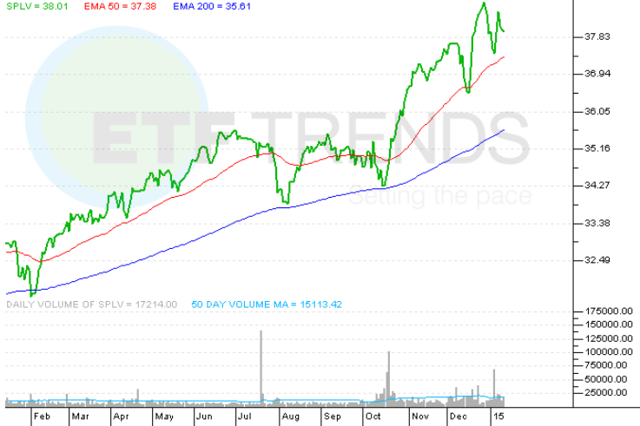Scalper1 News
 Summary Volatility in the markets is rising. Low-volatility stock ETFs are outperforming. A closer look at two low-vol ETFs. Low-volatility exchange traded funds that have taken a more cautious approach have outperformed the broader equities market as short-term concerns unbalanced stocks’ march upward. Over the past year, the PowerShares S&P 500 Low Volatility Portfolio ETF (NYSEArca: SPLV ) gained 19.2% and iShares MSCI USA Minimum Volatility ETF (NYSEArca: USMV ) rose 18.2%. Year-to-date, SPLV was up 0.1% and USMV was 0.5% higher. In contrast, the S&P 500 index increased 13.5% over the past year and fell 1.7% year-to-date. Market volatility is spiking as concerns mount over the potential effects of a plunge in crude oil prices. The CBOE Volatility Index, or VIX, closed at 21.6 Wednesday, compared to its historical range between 15 and 20. The VIX, a gauge of demand for protection against losses in U.S. equities, has oscillated more than 10% in three trading sessions since December 31. “Every time oil goes down into a new range, those fears reignite,” Paul Zemsky, head of multi-asset strategies at Voya Investment Management LLC, said in a Bloomberg article. “Will something happen in Russia? Will a hedge fund blow up? Which banks will get hammered by this?” However, a rise in volatility has helped the least volatile stocks standout. Moreover, low-volatility equities are experiencing greater demand due to low interest rates. Traditionally, investors would turn to fixed-income assets to diminish risk exposure. However, with rates more likely to rise and the U.S. economy expected to continue expanding, investors have turned to low-volatile stock options to capture a growing equities market and to hedge some of the market risks. For instance, both SPLV and USMV overweight outperforming defensive sector stocks. Specifically, SPLV includes a 20.2% tilt toward health care and 16.0% in consumer staples. USMV has 18.4% utilities and 15.6% consumer staples. Both ETFs also underweight the energy sector, the worst performing area of the market. SPLV takes 100 stocks from the S&P 500 that have exhibited the lowest volatility over the past year and weights holdings by the inverse of their volatility, so the largest components show the least amount of volatility. USMV also tracks low volatility stocks, but the ETF targets variances and correlations for all stocks, along with other risk factors. PowerShares S&P 500 Low Volatility Portfolio (click to enlarge) Max Chen contributed to this article . Scalper1 News
Summary Volatility in the markets is rising. Low-volatility stock ETFs are outperforming. A closer look at two low-vol ETFs. Low-volatility exchange traded funds that have taken a more cautious approach have outperformed the broader equities market as short-term concerns unbalanced stocks’ march upward. Over the past year, the PowerShares S&P 500 Low Volatility Portfolio ETF (NYSEArca: SPLV ) gained 19.2% and iShares MSCI USA Minimum Volatility ETF (NYSEArca: USMV ) rose 18.2%. Year-to-date, SPLV was up 0.1% and USMV was 0.5% higher. In contrast, the S&P 500 index increased 13.5% over the past year and fell 1.7% year-to-date. Market volatility is spiking as concerns mount over the potential effects of a plunge in crude oil prices. The CBOE Volatility Index, or VIX, closed at 21.6 Wednesday, compared to its historical range between 15 and 20. The VIX, a gauge of demand for protection against losses in U.S. equities, has oscillated more than 10% in three trading sessions since December 31. “Every time oil goes down into a new range, those fears reignite,” Paul Zemsky, head of multi-asset strategies at Voya Investment Management LLC, said in a Bloomberg article. “Will something happen in Russia? Will a hedge fund blow up? Which banks will get hammered by this?” However, a rise in volatility has helped the least volatile stocks standout. Moreover, low-volatility equities are experiencing greater demand due to low interest rates. Traditionally, investors would turn to fixed-income assets to diminish risk exposure. However, with rates more likely to rise and the U.S. economy expected to continue expanding, investors have turned to low-volatile stock options to capture a growing equities market and to hedge some of the market risks. For instance, both SPLV and USMV overweight outperforming defensive sector stocks. Specifically, SPLV includes a 20.2% tilt toward health care and 16.0% in consumer staples. USMV has 18.4% utilities and 15.6% consumer staples. Both ETFs also underweight the energy sector, the worst performing area of the market. SPLV takes 100 stocks from the S&P 500 that have exhibited the lowest volatility over the past year and weights holdings by the inverse of their volatility, so the largest components show the least amount of volatility. USMV also tracks low volatility stocks, but the ETF targets variances and correlations for all stocks, along with other risk factors. PowerShares S&P 500 Low Volatility Portfolio (click to enlarge) Max Chen contributed to this article . Scalper1 News
Scalper1 News